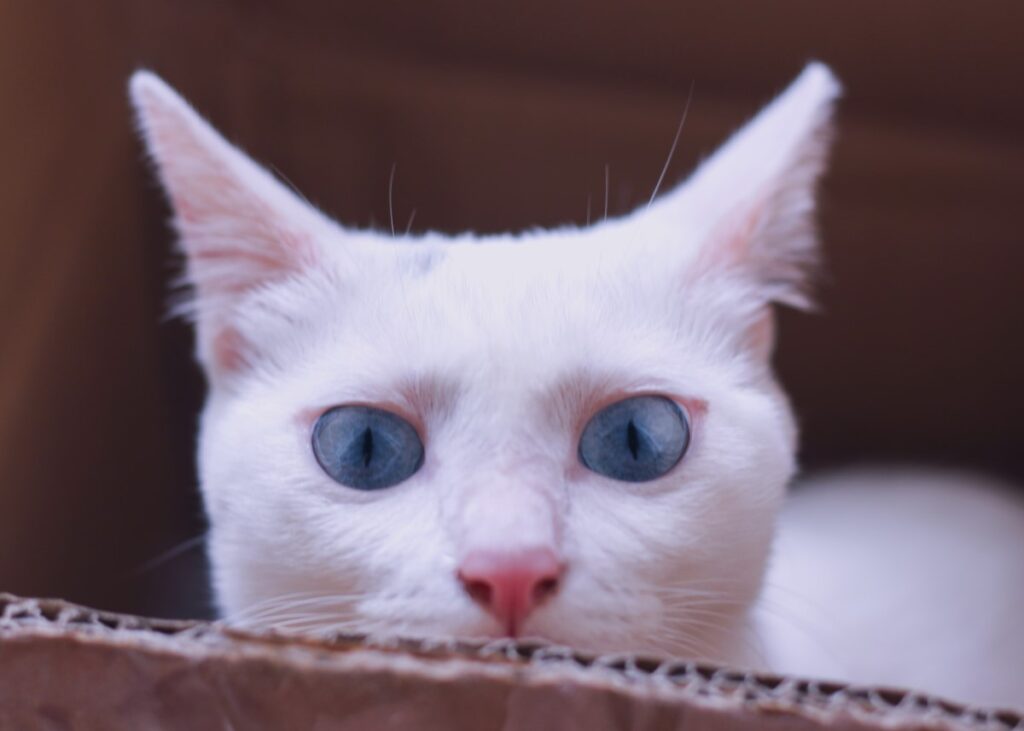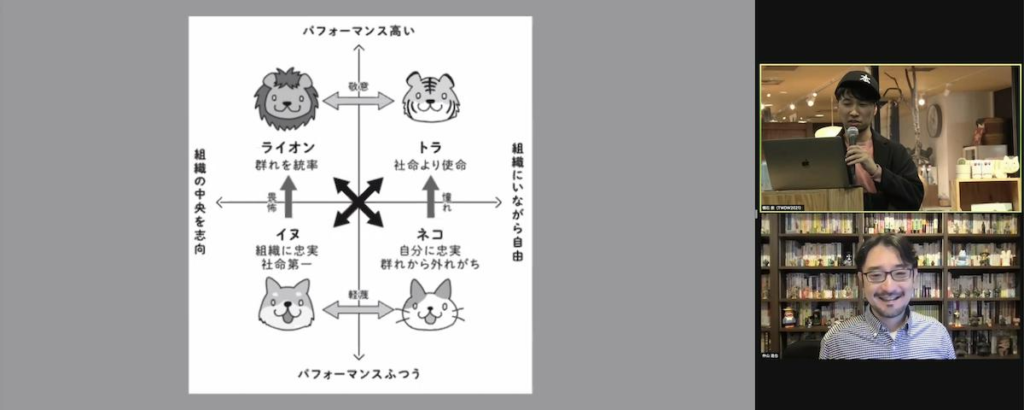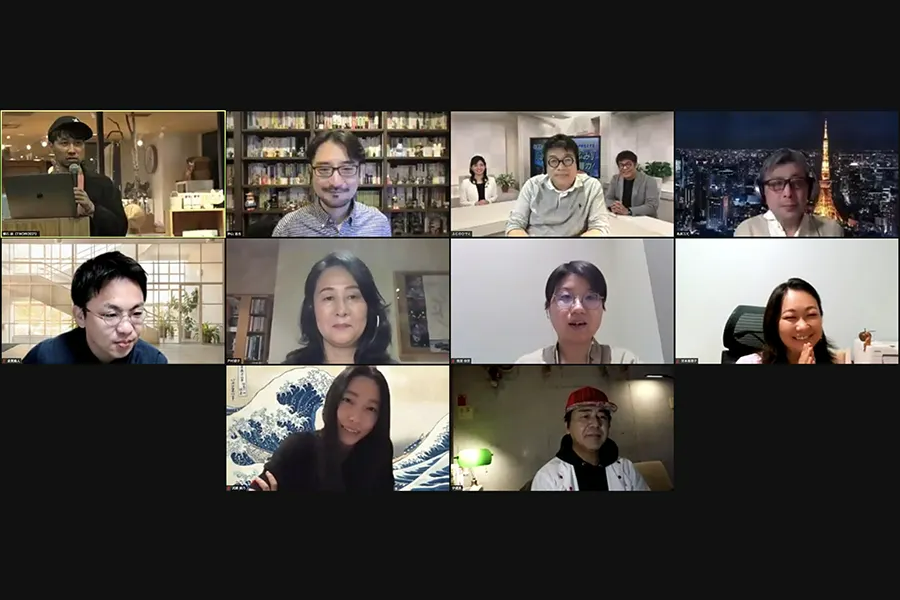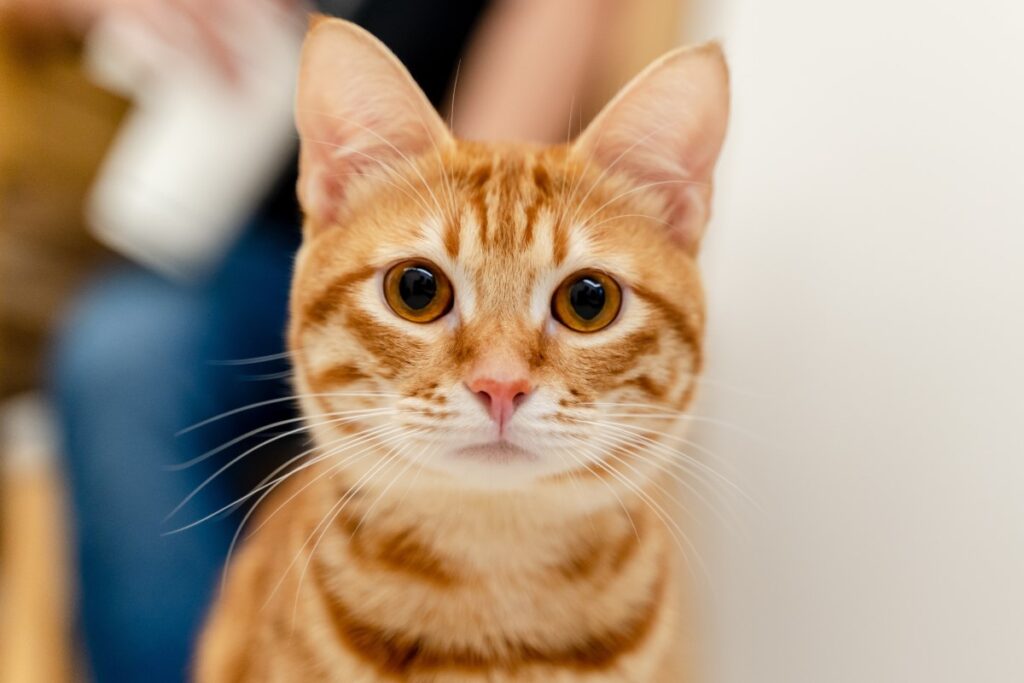Are you the “Cat” Personality in your Organization?

On Japan’s “Labor Thanksgiving Day” every November, the Tokyo Work Design Week (TWDW), a symposium on working styles, is held over a seven-day period. TWDW 2021, which marks the 9th anniversary of the event, was held online for 7 days in a row with the theme “Learn to Work Like a Cat.”
The overarching theme this year, “Learn to Work Like a Cat”, is based on the book “Working Style of ‘Organization Cat’” (published by Shoeisha) authored by Shinya Nakayama, the Principal of Rakuten University.
Here are some of the keynotes from the entire discussion.
What are the Four Personalities?
In his book, Mr. Nakayama groups working people into 4 categories of working styles. An “organization dog” is loyal to the organization while an “organization cat” prioritizes their own code of value instead of the organization. Then, there are “lions” which are conventional great leader types who lead people in the center of the organization while “tigers” are the next level of cats.

Traditionally, Japanese society has considered it a virtue to work as an organization dog with the goal of becoming a lion but recently, many people have become reluctant to take on managerial roles, which Mr. Nakayama says is proof that people’s views on working styles have changed. Additionally, due to their opposing views, organization dogs and cats don’t get along well and tend to hold each other in contempt.
Mr. Nakayama further added that in a diverse society, no matter what type of organization animal you are, everyone should respect each other’s’ values and make use of each other’s strengths to create resilient organizations for a happy society.
So, which Animal are You?
Next in line was an enriching discussion between the 10-panel members. According to Mr. Nakayama, this group of panelists consists of all “true tigers.” To confirm the same, they were each asked to fill in the “Organization Cat Personality Checklist”, a list of 10 items created by Mr. Nakayama to see how much of an organization cat they are, and all of them selected at least 8 of the items on the checklist, which goes to show how cat-like they are.
Organization Cat Personality Checklist
Are You an Organizational Cat? Here’s how you can identify!
- You feel bemused by the idea that work is a hardship and salary is an endurance fee.
- You don’t want to do a job that doesn’t provide meaningful value.
- You do what you think is good, even if it is outside the scope of your instructions.
- You may casually ignore instructions that contradict your beliefs
- You are not interested in winning titles or career competitions.
- You can’t be made to do work that doesn’t suit you or doesn’t require your unique skills.
- You are not inspired by seniors who succeeded following the company’s career rails.
- You prefer taking on challenges, even if there is a risk of failing and getting in trouble.
- You dislike being put into groups.
- You dislike being peer pressured or peer-pressuring others.
“Do Your Seniors Inspire You?”
One of the panelists who did not agree to this applying to her explained, “In my case, I didn’t tick the item ‘You are not inspired by seniors who succeeded following the company’s career rails’, as they do inspire me. I think this is different depending on which company you work at.”
In response to this opinion, a panelist, Mr. Fujino of Rheos Capital Works, who proposed the term “organization tiger” to Mr. Nakayama, alluded to the difference between “1996 Showa-era companies and 2021 Reiwa-era companies.”
He elaborated that currently, it is the 3rd year of the Reiwa era in Japan, while the year 1996 was the 3rd year of the Showa era, an era whose practices are still followed by many Japanese companies. According to him, the item ‘You are not inspired by seniors who succeeded following the company’s career rails’ is very common in 1996 Showa-era companies.
“Do You Like Being in a Group?”

Another panelist who only ticked 8 of the items explained why she did not tick off the item ‘I dislike being put into groups’ as, “it is inevitable to be put in a group in my line of work”
Mr. Nakayama explained, “The point here is whether you are being ‘put’ into a group or if you formed the group yourself, which makes you a tiger instead. It’s more about being uncomfortable when you are put in a group for no good reason.”
Another item on discussion was – “You dislike being peer pressured or peer-pressuring others”. Mr. Nakayama elaborated on this item by explaining that both being pressured to conform and the need to pressure others to conform is annoying to cats, whereas tigers are the ones who explain the reason why a task needs to be done.
On the other hand, dogs are people who apply peer pressure, urging co-workers to ‘just do what the boss says.’ They would protest if it is their boss who is applying peer pressure.
Organization Tiger Personality Checklist
Are You an Organizational Tiger? Here’s how you can identify!
- You act on a mission rather than a corporate mandate
- You have had painful turning points, such as going off the rails.
- You have outstanding achievements and individuality.
- You have someone who understands you in management.
- You have experienced a ‘one man does it all’ job before.
- You just cannot cope with being part of a herd.
- You get on well with other kinds of ‘tigers’
- You have built a team with people outside your company.
- You are involved in connecting people and supporting self-starting activities
- You are expanding your activities in a developmental career.
Mr. Nakayama also explained that instead of creating a career plan and working towards achieving it, organization tigers like to take on tasks that interest them. As they get to know more people, they are asked to do specific things. That will get the ball rolling until they reach an interesting career they have never even imagined.
Membership or Job-focused?

A panelist then pointed out that the differences between organization dogs and cats are similar to membership-type employment and job-focused employment.
While dogs are more membership-type, cats are job-focused. The membership type has a low turnover rate while job-focused has a high turnover rate. In terms of corporate training, mentorships, orientations, and job rotations are for membership-type employment while job-focused is more about self-improvement.
Mr. Nakayama also remarked that while organization tigers are often asked, ‘What do you actually do?’, it is the organization dogs that tend to fuss over what they actually do.
Do Organizations led by Tigers still need Dogs?
Responding with a strong ‘yes’ to this question, Mr. Nakayama said that Tigers are great at continuously exploring new and uncertain things while having fun with them and getting them set up. However, when it has been set up and is on track, they immediately lose interest and leave once it feels like an instruction manual should be created for it. If they can pass on the leadership responsibility to dogs at this perfect timing, what was established will run properly. So, organization dogs are also a very important talent in the context of work distribution that utilizes their different strengths.
One of the panelists, who was previously in a managerial role, drew from her experience and added, “When you create a team with only cats, it’s difficult to assign tasks that don’t suit a cat’s tastes, so you would have to do it yourself. That’s why it is better to have some dogs. With a mixed team, you can assign tasks to those who have a high affinity for them.”

Mr. Nakayama also pointed out that while the majority of people are dogs now, there are actually lots of cats just “putting on a dog’s skin.
He continued, “After the war, Japan experienced record economic growth, during which doing what was told maximized the companies’ performance and it became the favored working style. As a result, most people still think that becoming an organization dog is the way to go when you go to work at a company.” If you are loyal to the organization and work hard, you would get rewarded accordingly.
Because of the success stories of that golden age and environment, organization cats could still work in solidarity with the organization as dogs and achieve good results. “Thus, I believe that there are many cats still hiding under a dog’s skin.”, Mr. Nakayama added.
However, these “sneaky cats” will find it increasingly difficult in this age and time to improve the company’s performance by simply doing what they are told, making them disillusioned and frustrated with their job. Mr. Nakayama said that this is why he thinks many cats are finally starting to reveal their true selves.
Can a Cat Become a Tiger?

According to the panelists, Cats become tigers when they find the passion to do something they need to do. You don’t become a tiger by declaring that you are. You have to leave a mark first and produce some kind of result that defines your position in the industry.
Also, if you just love what you do and tenaciously complete your tasks to the best of your abilities, you can easily become an organizational tiger. Another tip from the panelists was getting to know a tiger from your organization. Observing how tigers who enjoy their work carry themselves will gradually bring you closer to them and help you become more like them.
If you want the freedom to do what you love, you will need to first commit to doing what you don’t like. Only after doing that, you can review your working style in the grand scheme of things.
Achieving things in your professional journey can also take you closer to being a tiger. Achieve something impressive, even if it is unintended, and let people realize that it would not have been possible without you.

One of the panelists also emphasized the importance of luck, saying that it’s also equally important to happen to be there when something is about to happen. Expanding on that, Mr. Nakayama added, “To catch a wave and ride it, you need to stand out. When you’re in that position, you’ll find others like you when you look around and get to know more of them.”
Let Your Cat Out!
In conclusion, you can be both cats or tigers in an organization. While tigers may be the next level of cats, you can still be an organization cat without being extremely capable or enthusiastic from the beginning.
There are many people who are actually cats but are just putting on a dog’s skin. But the way things are going, it is no longer necessary for cats to pose as dogs.
Some people might think cats cannot climb the corporate ladder. But cats can naturally evolve into tigers, which is a fun way to live and work. And there is bound to be a chance for you to do that in the near future.
So, organization cats must know that it is okay to let the cat out of the bag and free yourselves of the burden!

Production Cooperation: George Kuromiya + Note,Ltd







